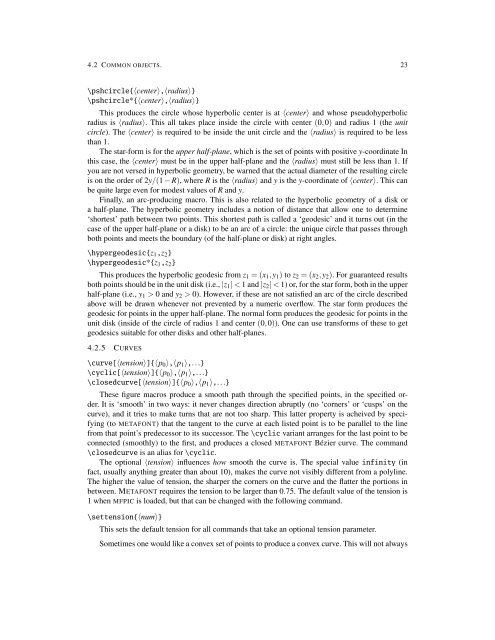You also want an ePaper? Increase the reach of your titles
YUMPU automatically turns print PDFs into web optimized ePapers that Google loves.
4.2 COMMON OBJECTS. 23<br />
\pshcircle{〈center〉,〈radius〉}<br />
\pshcircle*{〈center〉,〈radius〉}<br />
This produces the circle whose hyperbolic center is at 〈center〉 and whose pseudohyperbolic<br />
radius is 〈radius〉. This all takes place inside the circle with center (0,0) and radius 1 (the unit<br />
circle). The 〈center〉 is required to be inside the unit circle and the 〈radius〉 is required to be less<br />
than 1.<br />
The star-form is for the upper half-plane, which is the set of points with positive y-coordinate In<br />
this case, the 〈center〉 must be in the upper half-plane and the 〈radius〉 must still be less than 1. If<br />
you are not versed in hyperbolic geometry, be warned that the actual diameter of the resulting circle<br />
is on the order of 2y/(1 − R), where R is the 〈radius〉 and y is the y-coordinate of 〈center〉. This can<br />
be quite large even for modest values of R and y.<br />
Finally, an arc-producing macro. This is also related to the hyperbolic geometry of a disk or<br />
a half-plane. The hyperbolic geometry includes a notion of distance that allow one to determine<br />
‘shortest’ path between two points. This shortest path is called a ‘geodesic’ and it turns out (in the<br />
case of the upper half-plane or a disk) to be an arc of a circle: the unique circle that passes through<br />
both points and meets the boundary (of the half-plane or disk) at right angles.<br />
\hypergeodesic{z 1 ,z 2 }<br />
\hypergeodesic*{z 1 ,z 2 }<br />
This produces the hyperbolic geodesic from z 1 = (x 1 ,y 1 ) to z 2 = (x 2 ,y 2 ). For guaranteed results<br />
both points should be in the unit disk (i.e., |z 1 | < 1 and |z 2 | < 1) or, for the star form, both in the upper<br />
half-plane (i.e., y 1 > 0 and y 2 > 0). However, if these are not satisfied an arc of the circle described<br />
above will be drawn whenever not prevented by a numeric overflow. The star form produces the<br />
geodesic for points in the upper half-plane. The normal form produces the geodesic for points in the<br />
unit disk (inside of the circle of radius 1 and center (0,0)). One can use transforms of these to get<br />
geodesics suitable for other disks and other half-planes.<br />
4.2.5 CURVES<br />
\curve[〈tension〉]{〈p 0 〉,〈p 1 〉,...}<br />
\cyclic[〈tension〉]{〈p 0 〉,〈p 1 〉,...}<br />
\closedcurve[〈tension〉]{〈p 0 〉,〈p 1 〉,...}<br />
These figure macros produce a smooth path through the specified points, in the specified order.<br />
It is ‘smooth’ in two ways: it never changes direction abruptly (no ‘corners’ or ‘cusps’ on the<br />
curve), and it tries to make turns that are not too sharp. This latter property is acheived by specifying<br />
(to METAFONT) that the tangent to the curve at each listed point is to be parallel to the line<br />
from that point’s predecessor to its successor. The \cyclic variant arranges for the last point to be<br />
connected (smoothly) to the first, and produces a closed METAFONT Bézier curve. The command<br />
\closedcurve is an alias for \cyclic.<br />
The optional 〈tension〉 influences how smooth the curve is. The special value infinity (in<br />
fact, usually anything greater than about 10), makes the curve not visibly different from a polyline.<br />
The higher the value of tension, the sharper the corners on the curve and the flatter the portions in<br />
between. METAFONT requires the tension to be larger than 0.75. The default value of the tension is<br />
1 when MFPIC is loaded, but that can be changed with the following command.<br />
\settension{〈num〉}<br />
This sets the default tension for all commands that take an optional tension parameter.<br />
Sometimes one would like a convex set of points to produce a convex curve. This will not always

















